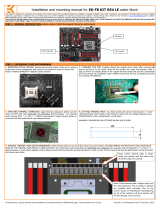
All disclosures, notices and warranty conditions are being written on EKWB web page. Please check terms of use. Released on 25
th
of April 2012.
This product is intended for installation only by expert users. Please consult with a qualified technician for installation. Improper installation may result in damage to your equipment. EK Water Blocks assumes no liability
whatsoever, expressed or implied, for the use of these products, nor their installation. The following instructions are subject to change without notice. Please visit our web site at www.ekwaterblocks.com for updates.
Before installation of this product please read important notice, disclosure and warranty conditions printed on the back of the box or our home page.
The barb hose fittings require only a small amount of force to screw them in; otherwise the high flow fittings might break. Th
ese fittings do not need to be tightened with much force because the
liquid seal is made using o-rings. The use of corrosion inhibitors is always recommended for any liquid cooling system.
STEP 1: GENERAL INFORMATION Sample photo of EVGA X79 CLASSIFIED motherboard
STEP 2: PREPARING YOUR MOTHERBOARD
1. REMOVING STOCK COOLER.
Remove all encircled screws. There are 8 screws
on the back of the motherboard that needs to be removed in order to remove both
SB (X79 PCH) as well as MOSFET factory cooling solution.
Carefully detach the original stock cooler after removing all
screws securing it to the board. Wipe off the remains (by using non–abrasive cloth or
qtip
,
as shown on sample photo) of the original thermal compound until the components and
circuit board are completely clean. EKWB recommends the use of denatured alcohol for
removing TIM leftovers.
3. APPLYING THERMAL COMPOUND. Apply thermal compound: lightly coat the
Intel X79 PCH
(SB) with electrically non-conductive thermal grease - for example
Arctic Cooling MX-2 ™,MX-4 ™ or GELID GC-Extreme ™ thermal grease. EKWB
recommends to apply thermal grease in cross form for best performance (see
sample picture).
4. CUTTING THERMAL PADS. Your block comes with thermal pads, some of which are
already pre-cut. Others have to be cut to smaller chunks in order to cover all the VRM
components such as MOSFETs and drivers. PLEASE REMOVE THE PROTECTIVE FOIL FROM
BOTH SIDES OF THE THERMAL PADS PRIOR TO INSTALLATION.
Replacement thermal pads: Thermal Pad A – 0.5mm (100x16mm), Thermal Pad A – 1mm (100x16mm).
5. PLACING THERMAL PADS ON MOTHERBOARD.
Place thermal pads you cut on PCB as shown on picture bellow (PLEASE REMOVE THE PROTECTIVE FOIL FROM BOTH
SIDES OF THE THERMAL PADS PRIOR TO INSTALLATION). EK recommends using small drops of electrically non-conductive (for example: Arctic Cooling MX-2 ™, MX-4 ™ or
GELID GC-Extreme™) thermal grease on each phase regulator (that is being covered with thermal pad; see picture below) in order to even further improve the thermal
performance of the EK-FB KIT EVGA X79 CLASSIFIED series water block.
Installation and mounting manual for EK-FB KIT EVGA X79 CLASSIFIED water block:
Place 1mm thermal pad in larger strip
over marked area
mosfet chips are covered.
Place 0.5mm thermal pad in larger strips over
the coils (inductors). This is merely to prevent
any possible short circuiting. Due to the
uneven nature of motherboard manufacturing
not all of the inductors will have contact with
the thermal pad. This is normal.
(for MOSFETs and IC drivers)
(for inductor coils)





